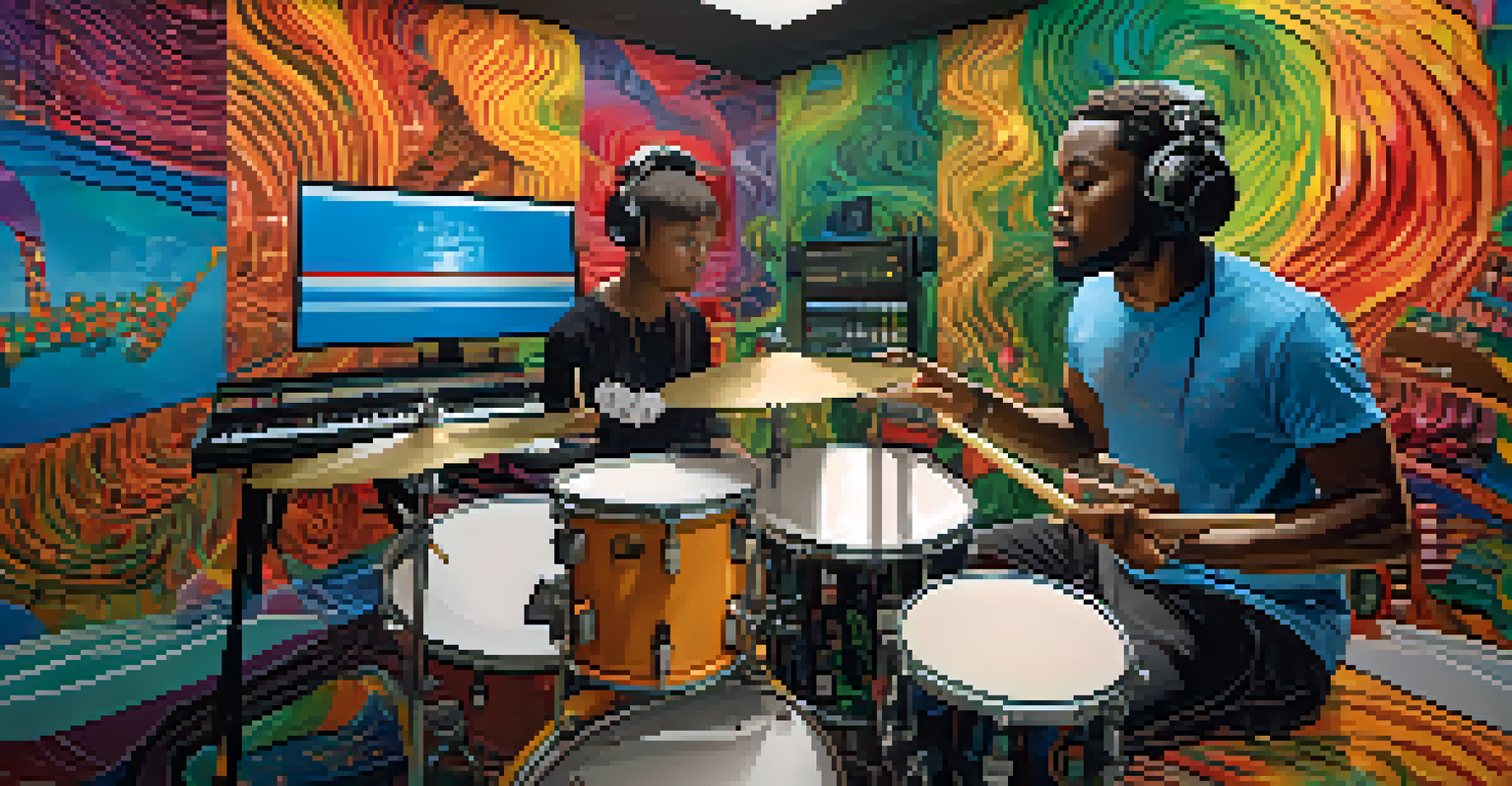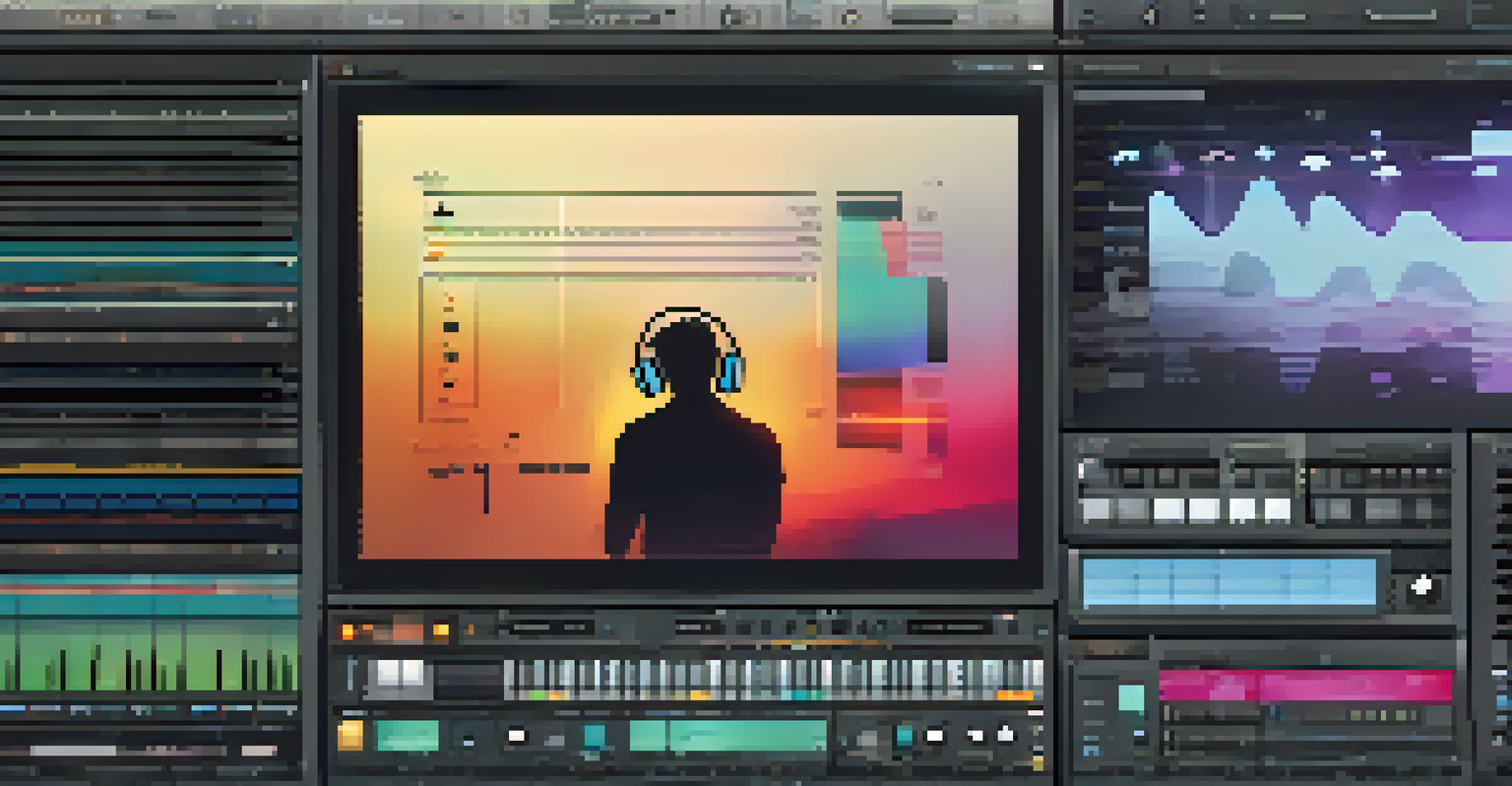How Cloud Technology is Changing Music Collaboration Practices

The Rise of Cloud Technology in Music Collaboration
Cloud technology has become a game changer in the music industry, enabling artists to collaborate from anywhere in the world. Gone are the days when musicians had to be in the same room to create magic; now, they can connect and share ideas seamlessly online. This shift has opened up opportunities for diverse and global collaborations that were previously unimaginable.
The future of music is not about the individual artist, but about collaboration and sharing.
With platforms like Google Drive, Dropbox, and specialized music software, artists can upload, share, and edit tracks in real-time. This not only enhances creativity but also speeds up the entire production process. Imagine a songwriter in New York working with a producer in London, all while exchanging ideas and files with the click of a button.
Moreover, the accessibility of cloud technology means that even emerging artists without a big budget can participate in high-quality collaborations. This democratization of music creation fosters innovation and allows fresh voices to enter the scene, enriching the overall music landscape.
Real-Time Collaboration: A New Era for Musicians
One of the most exciting features of cloud technology is real-time collaboration. Musicians can now jam together virtually, regardless of their physical locations. This capability allows for spontaneous creativity, where an idea can be shared and built upon instantly, much like an in-person jam session.

For instance, tools like Soundtrap and BandLab provide an online studio environment where multiple users can record and edit tracks together live. Picture a drummer laying down a beat while a guitarist adds riffs, all while communicating through video chat. This level of interaction mimics the traditional studio experience but with the added convenience of being online.
Cloud Tech Transforms Music Collaboration
Artists can now collaborate from anywhere in the world, breaking down geographic barriers and enabling diverse musical fusions.
Such platforms not only enhance creativity but also help in maintaining momentum during the creative process. When ideas can flow freely and be refined in real-time, the chances of producing a hit song increase significantly, giving artists a sense of immediacy and excitement.
Breaking Geographic Barriers in Music Creation
Cloud technology has effectively broken down geographic barriers, allowing artists from diverse backgrounds to collaborate. This melting pot of ideas and influences leads to the creation of unique sounds and styles that reflect a global culture. Artists can now draw inspiration from different musical traditions, blending them into something entirely new.
Technology has made it possible for musicians to connect and collaborate in ways we couldn't have imagined a decade ago.
For example, a musician in Nigeria can collaborate with an artist in Brazil, resulting in a fusion genre that resonates with both audiences. Such cross-cultural collaborations not only enrich the music but also foster understanding and appreciation between different communities. The world becomes a smaller place when creativity knows no borders.
Additionally, this global collaboration enhances the marketing potential for songs. With artists tapping into different markets, their music has a wider reach, increasing the chances of reaching diverse audiences and gaining international recognition.
Enhanced Accessibility and Affordability for Musicians
One of the most significant advantages of cloud technology in music collaboration is enhanced accessibility and affordability. With numerous free or low-cost platforms available, aspiring musicians can collaborate without breaking the bank. This opens the door for talent that might not have had the resources to connect with others before.
Cloud-based tools often come with built-in features like digital instruments, effects, and mixing options, allowing musicians to create high-quality recordings from the comfort of their homes. Instead of renting expensive studio time, artists can experiment and produce tracks at their own pace, making the creative process less daunting.
Real-Time Collaboration Enhances Creativity
Cloud technology allows musicians to work together in real-time, mimicking traditional jam sessions and boosting spontaneous creativity.
As a result, the music industry is witnessing a surge in indie artists who are using these technologies to produce and share their work. This shift not only encourages creativity but also challenges traditional music distribution models, creating a more inclusive landscape.
The Role of Cloud-Based Tools in Music Production
Cloud-based tools have revolutionized how music is produced, offering features that enhance collaboration and creativity. For instance, applications like Splice allow users to access a vast library of samples and loops that can be easily integrated into their projects. This resourcefulness makes it easier for artists to experiment with sounds and find their unique voice.
Additionally, many cloud platforms come equipped with collaborative features that let multiple users contribute to a single project. This means that an artist can invite others to edit, comment, or add to a track, fostering a sense of teamwork that is crucial for creative success.
The integration of artificial intelligence in some cloud tools is also noteworthy, as it can aid in mixing and mastering tracks, providing suggestions that enhance the overall sound. This support allows musicians to focus more on their creativity while streamlining the technical aspects of production.
Overcoming Challenges: Security and Reliability
While cloud technology offers numerous benefits, it also presents challenges, particularly concerning security and reliability. Musicians often worry about the safety of their intellectual property when sharing files online, which is a valid concern. Addressing these issues requires choosing reputable cloud services that prioritize data security and provide robust encryption.
Moreover, the reliability of internet connections can impact cloud-based collaboration. Artists need stable internet access to ensure smooth communication and file sharing. However, with advancements in technology and infrastructure, these issues are becoming less of a concern.
Accessibility Fuels Indie Music Growth
Low-cost cloud platforms empower aspiring musicians to create high-quality music without expensive studio fees, democratizing the industry.
By understanding and addressing these challenges, artists can fully leverage the benefits of cloud technology. Adopting best practices, such as regular backups and using secure platforms, can help mitigate risks while enjoying the collaborative advantages that cloud technology offers.
The Future of Music Collaboration in the Cloud
As cloud technology continues to evolve, the future of music collaboration looks incredibly promising. With ongoing advancements in artificial intelligence and machine learning, we can expect even more innovative tools that facilitate collaboration. Imagine a future where artists can compose alongside AI, enhancing their creativity in ways we can't yet fully envision.
Furthermore, as the demand for remote collaboration grows, more platforms will likely emerge, each catering to different needs and styles. This diversification will empower musicians to find the perfect tools that resonate with their creative processes, fostering even greater collaboration.

Ultimately, the evolution of cloud technology will continue to shape the music landscape, encouraging collaboration, creativity, and inclusivity. As artists embrace these changes, we can look forward to a future filled with exciting new sounds and groundbreaking music.